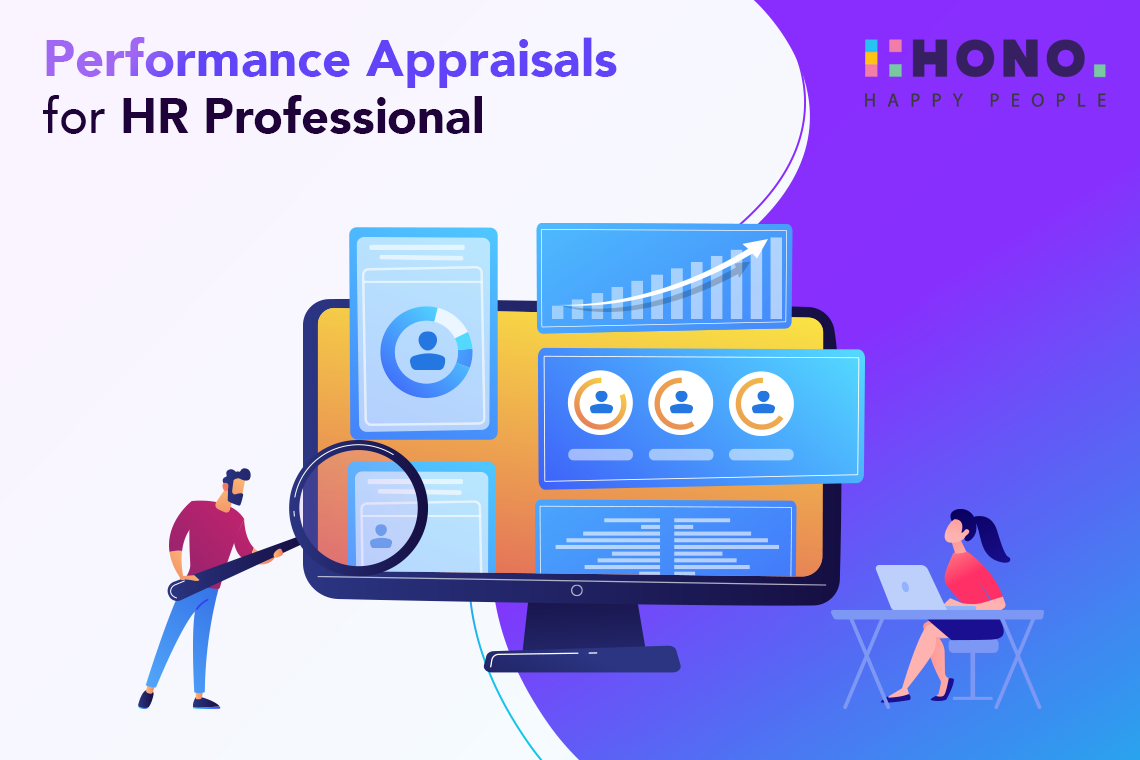- Performance Management
Rethinking Performance Appraisals: An HR Imperative
29 Apr, 2025 |

Akanksha Shekhar
With over 9 years immersed in the world of content marketing for SaaS, Cloud, HRMS and multiple other industries, Akanksha Shekhar currently leads the content initiatives as Manager of Content Marketing. Her expertise lies in the art of bringing words to life, creating engaging narratives and technically sound pieces that are both catchy and deeply informative.
As an HR professional, one of the most important parts in your role would be to ensure the team has completed the performance appraisal without any hassle. It is more than just a yearly review,it’s an opportunity to assess, motivate, and align employees with the company’s goals. Through performance appraisals, you can not only evaluate past performance but also guide future growth and ensure that the organization’s objectives are being met.
However, performance appraisals can often be misunderstood or mishandled if not approached with a preplanned process. HR professionals require to know how to differentiate between performance management and performance appraisal, as they are two different processes that serve different purposes. Performance management is a continuous process, while performance appraisal typically happens at set intervals. Knowing how to conduct appraisals using the right methods can make a significant impact on your team’s success. In this blog, we’ll explore what performance appraisals are, how to differentiate between performance management and performance appraisal, and highlight some of the most effective performance appraisal methods HR professionals can use.
What Is Performance Appraisal?
A performance appraisal is a process where an employee’s job performance is reviewed and evaluated by their manager or supervisor. It typically happens at regular intervals, such as annually or semi-annually, and focuses on how well the employee has met their job responsibilities and contributed to the organization’s goals. The performance appraisal helps identify strengths, areas for improvement, and future development opportunities, and it often leads to decisions about promotions, raises, or additional training.
For HR professionals, conducting effective performance appraisals is essential for keeping employees engaged and ensuring the organization is on track to meet its objectives.
Difference Between Performance Management and Performance Appraisals?
Performance management and performance appraisals are often used interchangeably, but they are actually two different concepts. Understanding how to differentiate between performance management and performance appraisal is important for HR professionals when designing effective performance appraisal methods. Here’s a breakdown for easier understanding:
|
Performance Management |
Performance Appraisals |
|
Performance Management is an ongoing process that involves setting goals, providing feedback, and making adjustments to help employees improve continuously. It’s a holistic approach that focuses on long-term development, ensuring employees stay aligned with organizational goals. Performance management happens throughout the year, with regular check-ins and feedback sessions. |
Performance Appraisals, on the other hand, are periodic evaluations that occur at set intervals, often annually or semi-annually. They focus on assessing an employee’s past performance, providing feedback on achievements, and addressing areas for improvement. While performance appraisals are a part of the performance management process, they are more focused on reviewing past performance rather than guiding future growth. |
Purpose of a Performance Appraisal
The purpose of a performance appraisal is to evaluate an employee’s work performance and provide feedback on how well they’ve met job expectations. It helps identify strengths and areas for improvement, which can guide decisions related to promotions, raises, or additional training. Performance appraisals also provide an opportunity for open communication between employees and managers, ensuring alignment with organizational goals and building employee development and motivation. By understanding how to effectively use performance appraisal methods, companies can also focus on employee development and motivation.
Ultimately, the purpose is not just to assess past performance, but to set the stage for future growth and ensure that both employees and the company are moving in the right direction.
Benefits of a Performance Appraisal
A well-conducted performance appraisal brings numerous benefits to both the organization and its employees. It’s more than just a way to assess past performance — it’s an opportunity to improve communication, set clear goals, and build employee development. Regular performance appraisals create a structured environment where feedback can be shared, goals can be aligned, and growth can be encouraged. Here are the key benefits of conducting performance appraisals:
- Helps identify strengths and areas for improvement, guiding employee development and training needs.
- Enhances communication between managers and employees, promoting transparency and trust.
- Aligns individual goals with organizational objectives, ensuring everyone is working toward the same vision.
- Provides a basis for rewarding and recognizing employees through promotions, raises, or bonuses.
- Increases employee motivation and engagement by giving them a clear understanding of their performance and growth opportunities.
Types of Performance Appraisals
There are several different types of performance appraisals that HR professionals can use, each with its own approach to evaluating employee performance. The right method depends on the organization’s goals, the type of work, and the employee’s role. Here are some of the most commonly used types of performance appraisals:
- 360-Degree Feedback: This appraisal method gathers feedback from a variety of sources, including peers, subordinates, and supervisors. It provides a well-rounded view of an employee's performance and interpersonal skills.
- Self-Assessment: In this approach, employees evaluate their own performance, identifying their strengths and weaknesses. This method encourages self-reflection and can lead to more open conversations during the appraisal process.
- Behaviorally Anchored Rating Scale (BARS): This method uses specific examples of behavior to rate an employee’s performance. It focuses on how an employee behaves in different situations, rather than just the outcome of their work.
- Management by Objectives (MBO): In MBO, employees and managers set specific, measurable goals at the beginning of the year, and the employee’s performance is then evaluated based on how well those goals were met.
- Objectives and Key Results (OKR) Approach: Similar to MBO, OKRs help employees align their personal objectives with broader company goals. Organizations use the OKR approach to track performance in a clear, flexible, and real-time way, helping employees stay focused and connected to broader goals.
Each type of performance appraisal has its own strengths and is best suited for different situations or organizational needs. The key is to choose a method that aligns with your company’s culture and goals, while also promoting employee growth and development.
Methods of Performance Appraisals
Effective performance appraisals are not just about the format but also about how they are conducted. Methods like regular check-ins, project-based reviews, peer evaluations, self-assessments, and goal-oriented approaches like OKRs help create a more continuous and engaging feedback process. Instead of relying only on annual reviews, these methods encourage real-time conversations, personal accountability, and stronger alignment between employee efforts and business goals.
Tips For Conducting Effective Performance Appraisals
To conduct effective performance appraisals, HR professionals should focus on a few key practices that promote fairness and employee development. Here are some tips:
- Set Clear Objectives and Goals: Ensure both the employee and manager are aligned on performance expectations and measurable goals.
- Build Ongoing Feedback: Provide regular feedback throughout the year to avoid surprises and encourage continuous improvement.
- Train Managers on Appraisal Processes: Equip managers with the tools to give constructive, unbiased feedback and evaluate performance consistently.
- Keep Communication Transparent and Clear: Use clear, specific examples and offer actionable feedback to help employees understand their performance and areas for growth.
Follow Up After Appraisal
Following up after a performance appraisal is essential to ensure that feedback is acted upon. It involves reviewing action plans, offering ongoing support, and monitoring progress toward set goals. Regular check-ins help employees stay focused, address any challenges, and recognize improvements, ensuring continuous growth and development.
Read More: Benefits of Performance Management Software for Fair Appraisals
Summing Up; Boost Employee Performance and Engagement with Effective Appraisals
Performance appraisals are a vital part of employee development, helping businesses assess strengths, address weaknesses, and align individual goals with organizational objectives. By conducting thoughtful and consistent appraisals, HR professionals can build a positive work environment and motivate employees to achieve their best.
To streamline the process, HRMS platforms like HONO can be incredibly helpful. HONO’s performance management system simplifies performance appraisals by offering features like automated feedback, goal tracking, and real-time insights, making it easier for HR teams to manage employee performance effectively.
With the right tools and approach, performance appraisals can become a powerful driver of growth for both employees and the organization.
Table of Content
- What Is Performance Appraisal?
- Difference Between Performance Management and Performance Appraisals?
- Purpose of a Performance Appraisal
- Benefits of a Performance Appraisal
- Types of Performance Appraisals
- Methods of Performance Appraisals
- Tips For Conducting Effective Performance Appraisals
- Follow Up After Appraisal
- Summing Up; Boost Employee Performance and Engagement with Effective Appraisals



